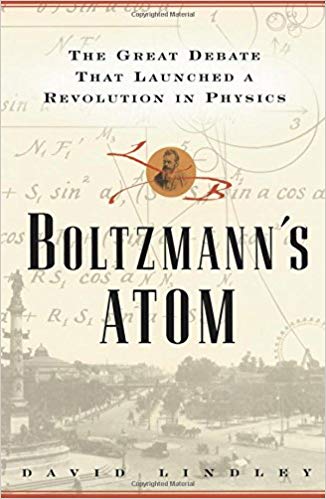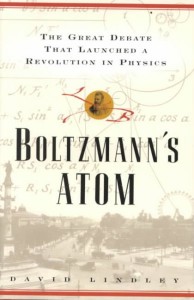
It might be hard to imagine now, but at the end of the 1800s, the scientific community was beginning to think it had more or less wrapped up all-things physics. Newton’s mechanics were well understood and Maxwell had recently shown how light behaved as a wave, giving a unified theory of electricity and magnetism. Little could they all imagine that everything would be turned on its head in just a few short years.
Presaging this transformation of physics was Ludwig Boltzmann, who was one of the leading figures of what we now call statistical mechanics. He showed how we could move beyond treating individual particles and think about them as large groups, think about their average properties. This allowed him to consider the properties of solids and liquids and gases on a scale that more directly connects with every day life. Maybe most importantly, he showed how the properties of these groups, or ensembles, of particles connected to the concept of entropy, which was a fairly vague concept before him. His impact to physics is immeasurable, and is enshrined in various concepts that bear his name, not least amongst them being the Maxwell-Boltzmann distribution and the Boltzmann factor.
However, during his life, his ideas were not so quick to catch on and were, in particular, challenged by people like Ernst Mach (yes, the one who devised the Mach scale of speed), who exposed a view that physics should only describe what is directly observed, that there was no room for theorizing what caused those observations. That, combined with Boltzmann’s relative isolation in a small university and his own near-schizophrenia with his status, led to a relatively slow acceptance of his ideas. Boltzmann’s ideas had, at their core, the concept of atoms, a concept that was not at all widely accepted during his time. As late as 1897, leading scientists such as Mach could exclaim “I don’t believe that atoms exist!”
Of course, there were theories of atoms before Boltzmann, dating back to the ancient Greeks. Lindley traces the development of our theories of atomic particles and Boltzmann’s contributions to those theories. Boltzmann’s own theoretical advances made predictions, based on the assumption of atoms, that were later validated and helped conclusively show that atoms do indeed exist (Einstein also played a critical role with his theory of Brownian motion). That Boltzmann’s assumptions were fundamentally correct was not a given, and that they led to predictions that agreed with observation did not prove them to be true. As Lindley notes: “You make an assumption and explore the consequences. This is exactly what scientists continue to do today, and the fact that a certain assumption leads to all kinds of highly successful predictions and explanations does not, strictly speaking, prove that the original assumption is correct.“
Lindley’s portrait of Boltzmann is both the story of a man who had some very profound personal issues and the history of a branch of science that presaged the quantum revolution. The story of the advancement of science is fascinating in its own right, as generations of scientists tried to tease out what, at the microscopic scale, was driving the macroscopic observations we make every day. Lindley describes the scientific environment of the time, in which a few big heavyweights dominated the discourse. A single scientist, working in relative isolation, like Boltzmann, could make huge impacts on his field. This isn’t as true today, where we seem to be delving more into details than bigger swaths of truth. Not that there aren’t any new big truths to discover, but rather that the kinds of technological advances that are rewarded demand digging into the details. And, the democratization of science — the shifting of science being a rich-man’s hobby to a true profession pursued by large armies of people — have made it so that it is harder to stand out in the proverbial field.
As for himself, Boltzmann was never happy. He always desired more recognition for his achievements and that typically meant moving to bigger and better positions at other universities. However, the moment he accepted such a position, he was riddled with doubts and often tried to undo the appointment. Particularly in Austria, where appointments were at least brought to the attention of the royals, this led to some level of infamy for the poor man. His vacillations were likely a reflection of some deeper level of depression or other mental condition, as he ultimately took his own life.
Finally, Lindley also provides some metacommentary on the scientific process itself. This is both through the continual argument between people like Mach and Boltzmann (Mach particularly disliked theorizing, stating, for example, that “the object of natural science is the connection of phenomena, but theories are like dry leaves which fall away when they have ceased to be the lungs of the tree of science“) as well as his own observations: “Science demands an element of creativity, and an element of faith. The creativity comes in thinking up hypotheses and theories that no one has ever thought of before. The faith comes in thinking that these hypotheses, when shown to be useful or successful in some way, bear a relation to what is loosely called reality.” Late in his life, Boltzmann, spurred on by the attacks by Mach and his followers, turned toward philosophy, in an attempt to understand the nature of truth. However, he never really became a philosopher, telling a colleague “Shouldn’t the irresistible urge to philosophize be compared to the vomiting caused by migraines, in that something is trying to struggle out even though there’s nothing inside?“
Altogether, Boltzmann’s Atom is an excellent portrait of a man and of an era in science. It is a lesson in how science advances, not necessarily through the unstoppable march of progress, but in fits and spurts as different personalities come and go. Boltzmann himself is an intriguing figure that bridges two different eras of science. We tend to forget both that science doesn’t always follow an obvious linear path in the search for understanding and that the people that push it forward are human with very human foibles. Boltzmann’s Atom reminds us of both.
